
Kelly Klein’s newest book is not “just a bunch of pretty pool pictures,” she says.
The images in this book are gritty. They’re sexy. They’re sculptural. And the 12-inch-by-13-inch, 6½-pound tome “Pools: Reflections” is nothing like its predecessor, “Pools,” which Ms. Klein published two decades ago.
“I felt it had been 20 years and it was time to do the sequel,” the East Hampton resident, who also splits her time between Manhattan and Florida, said during a telephone interview last week. “I wasn’t obsessed with pools at the time, but it seems I have become obsessed. I don’t know, I just love looking at the architecture of water in the ground. Swimming pools have now become just as important as the house and the landscaping. It used to be just a hole in the ground that you stick your pool in. Now, it’s become such a statement. After all this time has passed, the architecture of swimming pools has gotten even more incredible.”
The first book—which began as a research project for a pool Ms. Klein planned to build at her East Hampton home when she was formerly married to fashion designer Calvin Klein—took a look at the evolution of swimming pools from 1910 to the 1980s. Her newest project focuses on contemporary to current architecture, and doesn’t shy away from destruction, nudity and chaos.
“The challenge was to make sure this new book didn’t look anything like the old book,” she said. “I looked for pictures that did not look dated, pictures that looked very modern and cutting-edge. There’s beautiful pictures, there’s pools that have been in distress from hurricanes, being hit by cyclones. There’s graffiti pools. I was searching for the most interesting, captivating pictures that I could find.”
Her research process started by combing Google and various blogs, she said, looking up every single pool possible. Then, she fielded inquiries to architects, museums and photographers—both professional and amateur. Within a year, she had a couple thousand images at her disposal. She edited them down to 180.
The pools traverse the globe—from North America, Europe and South Africa to Asia, Australia and South America. The furthest Ms. Klein personally traveled for a shoot was Santiago, Chile, she said.
“Photography, it’s a fantastic way of capturing a moment, capturing something that instant, an unexpected moment that is fantastic or interesting or beautiful,” she mused. “I went to FIT, studied fashion, worked for Ralph [Lauren] and Calvin for 20 years, maybe more. And then, as I was getting separated from Calvin, I needed to figure out a new career for myself and I started taking pictures. I remained a fashion photographer until today. I don’t shoot as much as I used to. I’m pretty much being a mother right now, but I still take pictures for certain magazines.”
But before she mixed fashion with photography, and years before her divorce, she noticed an unsettling pattern within her circle of friends, which led to a new direction in her career path.
“Being in the fashion business and, also, I’m very involved in horse shows and showing horses, there’s a big gay community and very good friends of mine,” she said. “When I started doing books 22 years ago, a lot of my friends were getting sick and I just, I was like, ‘Oh my God, what can I do to help this situation?’”
Each of her five previous books have benefited a different AIDS foundation, she reported. Profits from “Pools: Reflections” will be donated to ACRIA, a Manhattan-based AIDS research and education organization, she added.
“It’s just my way of giving back, again with this book,” she said. “And this is an extension of the first book. It’s more lifestyles and looking at more trends.”
In the 1980s, spill-over infinity pools were king. Nowadays, swimming pools are going more sculptural—both in their architecture and surrounding art, she said. One example she found on the East End is captured by photographer Steven Klein in Bridgehampton.
“It’s one of my favorites. It’s kind of like a cement block built out of the ground,” Ms. Klein reported. “It looks like a piece of art at a distance, standing out in the field. It’s kind of a trend right now in building pools: building trough swimming pools, taken from horse troughs, cattle troughs. It’s not fancy. It’s kind of rugged, but it looks cool.”
Also, homeowners are installing art in and around their pools more than ever, and even writing words in them, Ms. Klein said, such as the Tom Sachs sculpture at the end of a text-laden pool in Austria. A pool in Montauk features a “tremendous” Frank West sculpture on the edge of its coping, she continued.
“I think when the infinity pool was really popular, a lot of people were building where they had amazing views of the ocean. Or they were on a mountain and could build at the edge of a cliff and it felt like the pool was spilling over the side of the mountain or into the ocean,” Ms. Klein said. “Today, many people aren’t building on that type of property. I think people have looked for doing more interesting things on their land when they don’t have an incredible view. They make the pool more of a sculpture within itself.”
For more information on “Pools: Reflections,” visit kellykleinstudio.com.